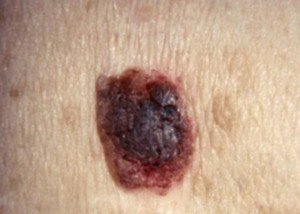
Middle age is that time where you may be discovering odd new growths on your skin and even what appear to be new moles.
Melanoma can take on the appearance of a new mole, and a new mole in middle age is more likely to eventually become melanoma when compared to a new mole in early childhood.
New Moles or Growths in Middle Age
“A new growth could be a mole, but could also be a host of other things,” says Dr. Janet Prystowsky, MD, a board certified dermatologist in New York, NY, with 30+ years’ experience.
“Not everything needs to be removed if you notice it for the first time,” she continues.
“Sometimes you may have a mole that you think is new but is actually rather old.
“However, it’s always best to contact your dermatologist if you notice any changes in your skin.
“On a case by case basis, your dermatologist may decide whether your new growth is something to be concerned about. If so, a biopsy will determine whether some form of surgery is necessary.”

Punch biopsy tools; different sizes for different size growths. Shutterstock/Peter Sobolev
A common new “growth” in middle age is a seborrheic keratosis (above).
These can scare people into thinking they’re melanoma, especially if they grow on the face.
There’s something about the face that tends to make people more nervous than if a new growth is on a leg or arm.
A seborrheic keratosis is a benign barnacle that can be mistaken for a mole or melanoma.
A dermatologist can often make an exact determination after viewing it through a dermatoscope, though there are times when a biopsy is required for a definite diagnosis.
Seborrheic keratoses do not need to be removed unless they are creating a cosmetic issue.
They will never turn into melanoma, though a melanoma can grow inside them by coincidence.
If you’re middle aged and have not yet gotten familiar with the various “growths,” spots or moles on your body and face, it’s time to take inventory so that you know what’s normally there and what is not. People past 40 also often begin getting angiomas on their skin.

In combination with her focus on early skin cancer detection and removal, Dr. Prystowsky provides a wide range of revitalizing and rejuvenating treatments.
 Lorra Garrick has been covering medical, fitness and cybersecurity topics for many years, having written thousands of articles for print magazines and websites, including as a ghostwriter. She’s also a former ACE-certified personal trainer.
Lorra Garrick has been covering medical, fitness and cybersecurity topics for many years, having written thousands of articles for print magazines and websites, including as a ghostwriter. She’s also a former ACE-certified personal trainer.
.









































